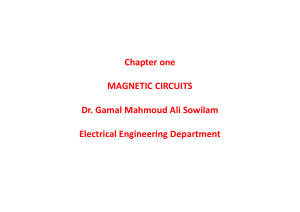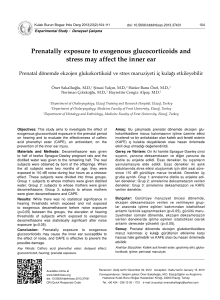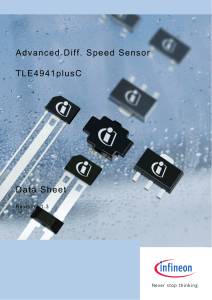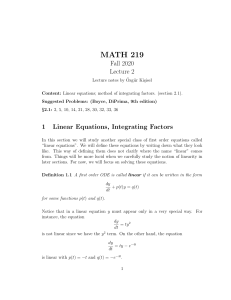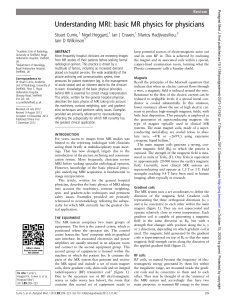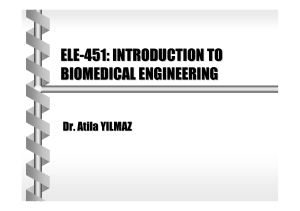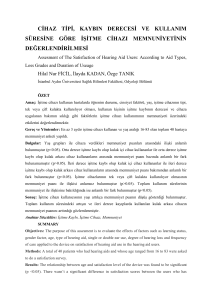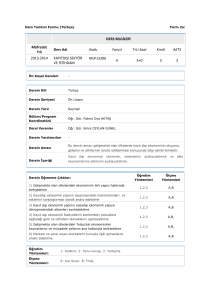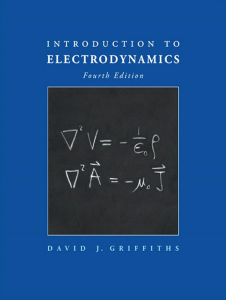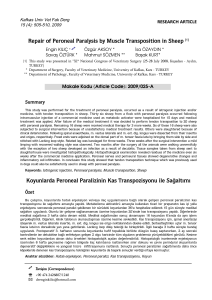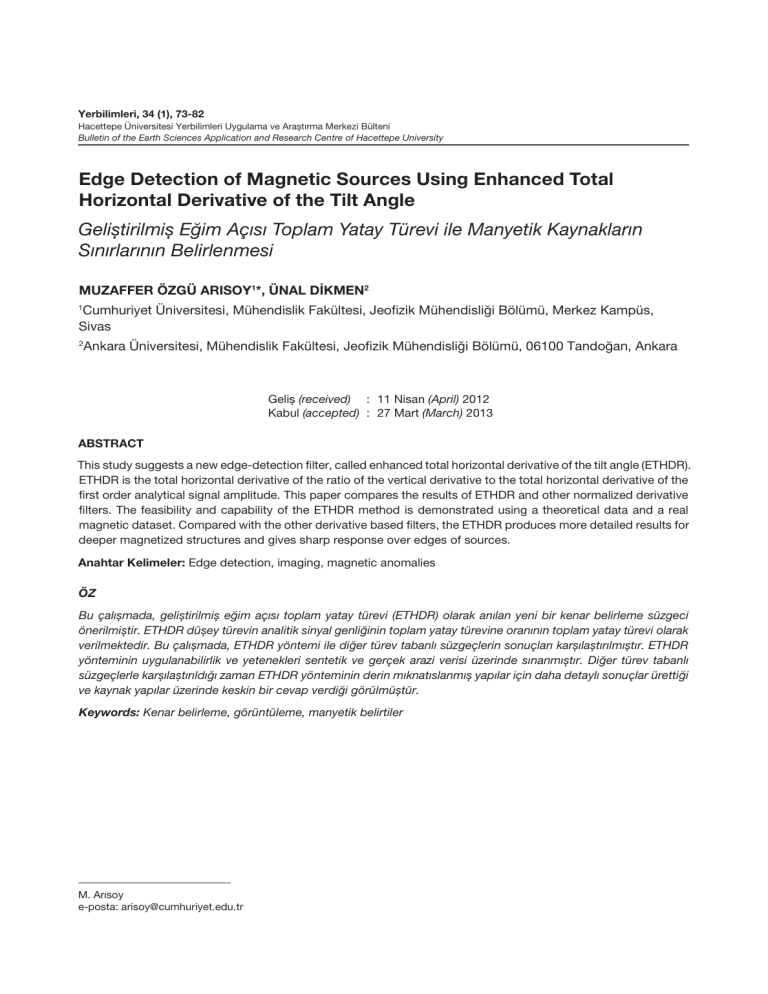
Yerbilimleri, 34 (1), 73-82
Hacettepe Üniversitesi Yerbilimleri Uygulama ve Araştırma Merkezi Bülteni
Bulletin of the Earth Sciences Application and Research Centre of Hacettepe University
Edge Detection of Magnetic Sources Using Enhanced Total
Horizontal Derivative of the Tilt Angle
Geliştirilmiş Eğim Açısı Toplam Yatay Türevi ile Manyetik Kaynakların
Sınırlarının Belirlenmesi
MUZAFFER ÖZGÜ ARISOY1*, ÜNAL DİKMEN2
Cumhuriyet Üniversitesi, Mühendislik Fakültesi, Jeofizik Mühendisliği Bölümü, Merkez Kampüs,
Sivas
1
2
Ankara Üniversitesi, Mühendislik Fakültesi, Jeofizik Mühendisliği Bölümü, 06100 Tandoğan, Ankara
Geliş (received) : 11 Nisan (April) 2012
Kabul (accepted) : 27 Mart (March) 2013
ABSTRACT
This study suggests a new edge-detection filter, called enhanced total horizontal derivative of the tilt angle (ETHDR).
ETHDR is the total horizontal derivative of the ratio of the vertical derivative to the total horizontal derivative of the
first order analytical signal amplitude. This paper compares the results of ETHDR and other normalized derivative
filters. The feasibility and capability of the ETHDR method is demonstrated using a theoretical data and a real
magnetic dataset. Compared with the other derivative based filters, the ETHDR produces more detailed results for
deeper magnetized structures and gives sharp response over edges of sources.
Anahtar Kelimeler: Edge detection, imaging, magnetic anomalies
ÖZ
Bu çalışmada, geliştirilmiş eğim açısı toplam yatay türevi (ETHDR) olarak anılan yeni bir kenar belirleme süzgeci
önerilmiştir. ETHDR düşey türevin analitik sinyal genliğinin toplam yatay türevine oranının toplam yatay türevi olarak
verilmektedir. Bu çalışmada, ETHDR yöntemi ile diğer türev tabanlı süzgeçlerin sonuçları karşılaştırılmıştır. ETHDR
yönteminin uygulanabilirlik ve yetenekleri sentetik ve gerçek arazi verisi üzerinde sınanmıştır. Diğer türev tabanlı
süzgeçlerle karşılaştırıldığı zaman ETHDR yönteminin derin mıknatıslanmış yapılar için daha detaylı sonuçlar ürettiği
ve kaynak yapılar üzerinde keskin bir cevap verdiği görülmüştür.
Keywords: Kenar belirleme, görüntüleme, manyetik belirtiler
M. Arısoy
e-posta: [email protected]
74
Yerbilimleri
INTRODUCTION
Delineating edges of magnetized structures is a
common application of magnetic data to geological interpretation. Horizontal and vertical derivatives are routinely used to enhance details
in magnetic data. The total horizontal derivative
and analytical signal are two effective tools that
are used to detect the edges of magnetized
structures (Pilkington and Keating, 2004; Cooper and Cowan, 2008; Cooper, 2009). However,
if the dataset contains features with a large variation in amplitude, then the features with small
amplitudes may be difficult to outline.
In recent years, a number of methods, called
balanced or normalized derivative methods,
were introduced to overcome this problem
(Cooper and Cowan, 2006). As a result of the
exponential increase in computing power and
the widespread use of geophysical commercial
software packages, these methods are being
used more effectively.
EDGE DETECTION
A commonly used edge detection filter is the
total horizontal derivative (THDR) and is given
by (Cordell and Grauch, 1985) as:
2
=
THDR
2
∂T ∂T
+
∂x ∂y
(1)
where T is the magnetic field, ∂T/∂x and ∂T/∂y
are the two orthogonal horizontal derivatives of
the magnetic field. Figure 1a shows the magnetic response of three vertical-sided prisms with
depths to the top of 1, 3 and 5 km from northwest corner to south-east corner, respectively.
Uniformly distributed random noise of amplitude equal to 0.5% of the maximum magnetic
data amplitude is added to the magnetic data.
In terms of similarity, the magnetization intensity of all bodies is set at 1 A/m, and all bodies have a 5km depth extent. It is clear that all
magnetized bodies produce a visible anomaly
(Figure 1a), but the edges of the third body in
the southeast region, the deepest, are difficult
to delineate. Figure 1b shows the THDR of
magnetic anomaly in Figure 1a. Imaging edges
of the deeper prism is poor while edges of the
shallower bodies are well mapped. Thus, one
can concluded that THDR is more effective in
imaging shallower bodies than deeper one.
The expression of the amplitude of the analytical signal (AS) for 3D structures is given by Roest et al (1992) as:
2
AS =
2
2
∂T ∂T ∂T
+
+
∂x ∂y ∂z
(2)
where ∂T/∂z is the vertical derivative of the
magnetic field. The maxima of AS is very useful
for delineating edges of magnetic sources because of the amplitude of the analytical signal
peaks over magnetic sources. The most important benefit of the analytical signal is that, in the
2D case, it is independent of the magnetization direction, but this is not true in the 3D case
(Li, 2006). However, if more than one magnetic
source is present, the result of the analytical
signal is dominated by shallow sources. Figure
1c shows an AS map of the magnetic data in
Figure 1a. The maxima of AS of the magnetic
data produce clear resolution of the shallower
bodies, but do not delineate the deeper body
very well.
A number of methods have been proposed to
make subtle anomalies more visible. The first
filter developed for this purpose was the tilt
angle (Miller and Singh, 1994), which is the ratio
of the vertical derivative to the absolute value of
the horizontal derivative of the magnetic field:
∂T
Tilt = tan −1 ∂z THDR
(3)
The tilt angle amplitudes are restricted to values between –π/2 and +π/2; thus the method
delimitates the amplitude variations into a certain range. Tilt angle therefore functions like
an automatic-gain-control filter, and therefore
responds equally well to shallow and deep sources. The amplitude of the tilt angle is positive over the magnetic sources, crosses through
zero at or near the edge of the source, and is
negative outside the source. Figure 1d shows
the tilt angle of the magnetic data in Figure 1a.
Arısoy ve Dikmen
75
Figure 1.A comparison of derivative-based filters: (a) Synthetic magnetic data resulted from three prismatic bodies with depths of 1, 3 and 5 km from north-west corner to south-east corner, respectively. Image covers 100×100 km area. Uniformly distributed random noise of amplitude equal to 0.5% of the maximum
magnetic data amplitude is added to the magnetic data. (b) Total horizontal derivative of magnetic data
in (a). (c) Analytical signal of magnetic data in (a). (d) Tilt angle of magnetic data in (a). (e) Total horizontal
derivative of the tilt angle (THDR_Tilt) of magnetic data in (a). (f) Theta map of magnetic data in (a). (g)
Horizontal tilt angle (TDX) of magnetic data in (a). (h) Enhanced total horizontal derivative of the tilt angle
(ETHDR) of magnetic data in (a).
Şekil 1. Türev tabanlı süzgeçlerin karşılaştırılması: (a) Kuzey-batıdan güney doğuya doğru sırasıyla derinlikleri 1,
3 ve 5 km olan üç prizmatik yapıdan hesaplanan yapay manyetik veri. Görüntü 100×100 km’ lik bir alanı
göstermektedir. Manyetik veriye, manyetik verinin en büyük genlik değerinin 0.5%’ i kadar gelişigüzel rastsal gürültü eklenmiştir. (b) (a)’ da verilen manyetik verinin toplam yatay türevi. (c) (a)’ da verilen manyetik
verinin analitik sinyali. (d) (a)’ da verilen manyetik verinin eğim açısı. (e) (a)’ da verilen manyetik verinin eğim
açısı toplam yatay türevi (THDR_Tilt). (f) (a)’ da verilen manyetik verinin Theta haritası. (g) (a)’ da verilen
manyetik verinin yatay eğim açısı (TDX). (h) (a)’ da verilen manyetik verinin geliştirilmiş eğim açısı toplam
yatay türevi (ETHDR).
76
Yerbilimleri
The tilt angle is relatively smooth and positive
over the bodies. It can be followed that the response of the tilt angle is blurred due to the model depth. The tilt angle produces a zero value
over the source edges.
Verduzco et al (2004) presented an edge detector, which is the total horizontal derivative of the
tilt angle (THDR_Tilt):
2
THDR
=
_ Tilt
2
∂Tilt ∂Tilt
+
∂x ∂y
(4)
THDR_Tilt is independent of the geomagnetic
field and generates maximum values over the
edges of the magnetized bodies. Figure 1e
shows the THDR_Tilt of the magnetic data in Figure 1a. The THDR_Tilt delineates model edges
well, as the amplitude of the THDR_Tilt peaks
over magnetic sources, but the results for the
deeper bodies are not so effective. Moreover,
in the presence of noise, the THDR_Tilt strongly
amplifies noise in the data (Figure 1e).
Wijns et al (2005) introduced the Theta map (θ),
which is the normalization of the THDR by the
AS:
THDR
cos θ =
AS
The horizontal tilt angle is the normalization of
the amplitude of the total horizontal derivative
by the vertical derivative. Figure 1g shows the
TDX of the magnetic data in Figure 1a. TDX responds equally well to shallow and deep bodies,
and also delineates the edges of all the bodies
well. TDX has a much sharper gradient over the
edges of the magnetized bodies. The geometric illustrations of the THDR, AS, Tilt and TDX
are shown in Figure 2.
(5)
Figure 1f shows the theta map of the magnetic data in Figure 1a. The theta map delineates
model edges well, but the response of deeper
bodies is diffused; consequently, it does not
produce the expected sharp gradient over the
edges.
Recently, Cooper and Cowan (2006) presented the horizontal tilt angle method (TDX) as an
edge detector:
EDGE ENHANCEMENT USING THE
ENHANCED TOTAL HORIZONTAL
GRADIENT OF THE TILT ANGLE
The use of THDR and AS filters in magnetic data interpretation is traditional. However,
when the data contain magnetic anomalies
with a wide range of amplitudes, the results of
THDR and AS filters are frequently dominated
by high-amplitude anomalies, obscuring subtle
anomalies. Balanced or normalized derivative
methods have been introduced to overcome
this problem. However, the results of the normalized derivative methods for the deeper bodies are not so effective, as response is blurred
due to the source depth. In this study a new
edge detector is introduced to overcome this
problem.
The proposed ETilt filter is the ratio of the vertical derivative to the total horizontal derivative
of the AS:
∂T
∂z
ETilt = tan −1 k
2
2
∂A ∂A
+
∂x ∂y
(6)
(7)
where
k=
THDR
TDX = tan −1
∂T
∂z
1
2
dx + dy 2
(8)
k is the dimensional correction factor. dx and
dy are sampling intervals in the x and y directions, respectively. The dimensional correction factor, k, does not have an effect on the
Etilt response. We suggest the use of the total
Arısoy ve Dikmen
77
Figure 2.The geometric definitions of the THDR, AS, Tilt and TDX.
Şekil 2. THDR, AS, Tilt ve TDX’ nın geometrik anlamları.
horizontal derivative of the ETilt as an edge detector (enhanced total horizontal derivative of
the tilt angle-ETHDR):
2
=
ETHDR
2
∂ETilt ∂ETilt
+
∂x ∂y
(9)
Figure 1h shows the ETHDR of the magnetic
data in Figure 1a. The ETHDR delineates the
edges of the all bodies better than the filters
discussed above, as it produces a very sharp
gradient over the edges of the bodies. Thus,
structural interpretation is very easy and powerful using the presented method. Most normalized derivative methods are so effective not
only shallow bodies but also deeper bodies
(see Figure 1d-g), but all normalized derivative
methods present a diffuse response to deeper
structures. However, the presented method
produces very clear resolution, not only in shallow bodies but also deeper bodies. Thus, if
more than one magnetic source is present, and
some of the sources are very close to each other, the ETHDR filter outlines the edges of bodies very well. The responses of existing filters,
ETilt and ETHDR filters to 2D prism and vertical
contact models are given in Figure 3. Figure 3
gives readers a much better idea of the behavior of the ETHDR method. The ETHDR peaks
over the edges of the model and the distance
of the drop to half of the peak amplitude is very
narrow, as expected from an edge detector
(see Figure 3). The method is dependent of geomagnetic inclination. For this reason, the data
should be previously reduced to pole. A disadvantage of the presented method is that, because the ETHDR filter uses derivatives of a derivative-based filter, it strongly amplifies noise
78
Yerbilimleri
Figure 3.Magnetic, THDR, AS, Tilt, THDR_Tilt, Theta, TDX, ETilt and ETHDR responses resulted from 2D prism
and vertical contact models. All bodies are magnetized in a vertical field.
Şekil 3. 2B prizma ve düşey kontak modellerinin manyetik, THDR, AS, Tilt, THDR_Tilt, Theta, TDX, ETilt ve ETHDR
cevapları. Tüm yapılar düşey alanda mıknatıslanmıştır.
in the data. Figure 4a-d show the ETHDR images of the synthetic magnetic data in Figure 1a
that have been corrupted with random noise of
amplitude equal to 1%, 2%, 3% and 5% of the
maximum magnetic data amplitude, respectively. The results show that the noise should be
smaller in amplitude than the actual edges of
sources (e.g., noise levels of %1 and %2). In
this case, the edges are clearly resolved. For
relatively high levels of noise, the method will
not be able to discriminate between edges and
noise (see the response of south-east body in
Figure 4d).
APPLICATION TO AEROMAGNETIC
DATASET
For comparison, the present and previous methods are demonstrated on an aeromagnetic
Arısoy ve Dikmen
79
Figure 4.A comparison of different amounts of noise effects on the ETHDR responses. (a) ETHDR image map of
magnetic data in Figure 1a. Random noise of amplitude equal to 1% of the maximum magnetic data
amplitude is added to the magnetic data. (b) ETHDR image map of magnetic data in Figure 1a. Random
noise of amplitude equal to 2% of the maximum magnetic data amplitude is added to the magnetic data.
(c) ETHDR image map of magnetic data in Figure1a. Random noise of amplitude equal to 3% of the
maximum magnetic data amplitude is added to the magnetic data. (d) ETHDR image map of magnetic
data in Figure 1a. Random noise of amplitude equal to 5% of the maximum magnetic data amplitude is
added to the magnetic data.
Şekil 4. Farklı miktarlarda gürültünün ETHDR sonuçları üzerine etkileri. (a) Şekil 1’ de verilen manyetik verinin ETHDR görüntü haritası. Manyetik veriye, manyetik verinin en büyük genlik değerinin 1%’ i kadar gelişigüzel
rastsal gürültü eklenmiştir. (b Şekil 1’ de verilen manyetik verinin ETHDR görüntü haritası. Manyetik veriye,
manyetik verinin en büyük genlik değerinin 2%’ si kadar gelişigüzel rastsal gürültü eklenmiştir. (c) Şekil
1’ de verilen manyetik verinin ETHDR görüntü haritası. Manyetik veriye, manyetik verinin en büyük genlik
değerinin 2%’ ü kadar gelişigüzel rastsal gürültü eklenmiştir. (d) Şekil 1’ de verilen manyetik verinin ETHDR
görüntü haritası. Manyetik veriye, manyetik verinin en büyük genlik değerinin 5%’ i kadar gelişigüzel rastsal
gürültü eklenmiştir.
data from Eskisehir and surrounding region.
The tectonic map and the original aeromagnetic data of the Eskisehir and surrounding region is shown in Figure 5a and Figure 5b, respectively. The aeromagnetic data is 170×170
km in size and has a grid resolution of 1 km in
both horizontal directions. The data mostly covers the Eskisehir fault zone, which comprises
of successive fault segments (Koçyiğit, 2000).
The Eskisehir fault and its segments extend in
a Northwest to Southeast direction. Figure 5c
shows reduction to pole (Baranov, 1957; Baranov and Naudy, 1964) applied aeromagnetic
data. Figure 5d is the total horizontal derivative and Figure 5e is the analytical signal of the
magnetic data in Figure 5c, respectively. The
80
Yerbilimleri
Figure 5.Application to aeromagnetic data: (a) Tectonic map of the Eskisehir and surrounding region (modified
from Özsayın and Dirik, 2007). (b) Original aeromagnetic image from the Eskisehir region. Aeromagnetic
data covers a 170×170 km area. Grid interval is 1 km in both horizontal directions. (c) Reduced to magnetic pole aeromagnetic image from the Eskisehir region in (b). (d) Total horizontal derivative of magnetic
data in (c). (e) Analytical signal of magnetic data in (c). (f) Tilt angle of magnetic data in (c). (g) Total horizontal derivative of the tilt angle (THDR_Tilt) of magnetic data in (c). (h) Theta map of magnetic data in (c).
(i) Horizontal tilt angle (TDX) of magnetic data in (c). (j) Enhanced total horizontal derivative of the tilt angle
(ETHDR) of magnetic data in (c).
Şekil 5. Havadan manyetik veri üzerinde uygulama: (a) Eskişehir bölgesi ve civarının tektonik haritası (Özsayın
ve Dirik, 2007’ den değiştirilerek alınmıştır). (b) Eskişehir bölgesi havadan manyetik veri görüntü haritası.
Veri 170×170 km’ lik bir alanı göstermektedir. Grid aralığı her iki yatay yönde 1 km’ dir. (c) (b)’ de verilen
Eskişehir bölgesi manyetik verisinin kutba indirgenmiş görüntü haritası. (d) (c)’ de verilen manyetik verinin
toplam yatay türevi. (e) (c)’ de verilen manyetik verinin analitik sinyali. (f) (c)’ de verilen manyetik verinin
eğim açısı. (g) (c)’ de verilen manyetik verinin eğim açısı toplam yatay türevi (THDR_Tilt). (h) (c)’ de verilen
manyetik verinin Theta haritası. (i) (c)’ de verilen manyetik verinin yatay eğim açısı (TDX). (j) (c)’ de verilen
manyetik verinin geliştirilmiş eğim açısı toplam yatay türevi (ETHDR).
Arısoy ve Dikmen
original aeromagnetic, reduction to pole applied aeromagnetic, total horizontal derivative and
analytical signal images are dominated by the
high-amplitude anomalies from Eskisehir fault
zone and its segments. Figure 5f-i show the
Tilt, THDR_Tilt, theta map and TDX, respectively. Figure 5j shows the ETHDR image of the
magnetic data in Figure 5c. The results of the
normalized derivative methods in Figure 5f-i
show greatly improved detail, particularly in the
southwest region. Nevertheless, the results are
more diffuse than the ETHDR image in Figure 5j.
CONCLUSIONS and RECOMMENDATIONS
A new edge detection filter, ETHDR, has been
introduced for interpretation of magnetic data.
The filter has been compared with other commonly used edge detection filters; it gives very
sharp response over edges of sources compared with the existing filters. The results show
that ETHDR is an effective tool for enhancing
subtle detail and delineating edges of shallow
and deep structures in magnetic data. The filter was demonstrated using both synthetic and
an aeromagnetic dataset. Basically the ETHDR
produces an image that is close to pi/2 when
the vertical derivative is positive and is close to
-pi/2 when vertical derivative is negative. Hence
the ETHDR edge detector shows similar behavior as zero contour of vertical derivative. The
ETHDR filter strongly amplifies noise in the data
as it uses derivatives of a derivative-based filter.
Before application of the ETHDR filter on the
noisy data, an upward continuation of the magnetic anomaly or low-pass filtering may reduce
the noise effect. It is believed that, within the
edge enhancement concept, future researchers
will introduce many new methods.
REFERENCES
Baranov, V., 1957. A new method for interpretation of aeromagnetic maps, Pseudogravimetric anomalies. Geophysics, 22,
359–383.
Baranov,V., and H. Naudy, 1964. Numerical
calculation of the formula of reduction
to the magnetic pole. Geophysics, 29,
67–79.
81
Cooper, G.R.J., 2009. Balancing images of potential-field data. Geophysics, 74(3),
L17-L20.
Cooper, G.R.J., and Cowan, D.R., 2006. Enhancing potential field data using filters
based on the local phase. Computers &
Geosciences, 32(10), 1585-1591.
Cooper, G.R.J., and Cowan, D.R., 2008. Edge
enhancement of potential-field data
using normalized statistics. Geophysics, 73(3), H1-H4.
Cordell, L., and V.J.S. Grauch, 1985. Mapping
basement magnetization zones from
aeromagnetic data in the San Juan basin, New Mexico, in W. J. Hinze, ed.,
The utility of regional gravity and magnetic anomaly maps: SEG, 181-197.
Koçyiğit, A., 2000. Seismicity of the southwestern
part of Turkey. BADSEM 2000-Symposium on Seismicity of the Southwestern
part of Turkey, İzmir, 30-39.
Li, X., 2006. Understanding 3D analytic signal
amplitude. Geophysics, 71(2), B13-B16.
Miller, H.G., and Singh, V., 1994. Potential field
tilt__a new concept for location of potential filed sources. Journal of Applied
Geophysics, 32, 213-217.
Özsayın, E., and Dirik, K., 2007. Quaternary
activity of the Cihanbeyli and Yeniceoba Fault zones: İnönü-Eskişehir fault
system, central Anotalia. Turkish Journal of Earth Sciences. 16, 471-492.
Pilkington, M., and Keating, P., 2004. Contact
mapping from gridded magnetic data –
a comparison of techniques, Exploration Geophysics, 35, 206-311.
Roest, W.R., Verhoef, J., and Pilkington, M.,
1992. Magnetic interpretation using the
3-D analytic signal. Geophysics, 57(1),
116-125.
Verduzco, B., Fairhead, J.D., Green, C.M., and
MacKenzie, C., 2004. New insights into
magnetic derivatives for structural mapping. The Leading Edge, 23(2), 116-119.
Wijns, C., Perez, C., and Kowalczyk, P., 2005.
Theta map: edge detection in magnetic
data. Geophysics, 70(4), L39-L43.

